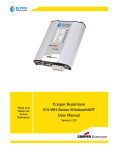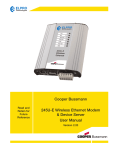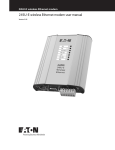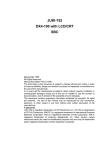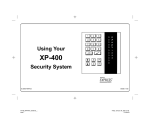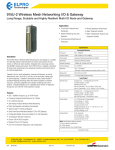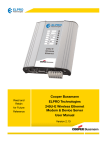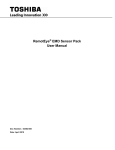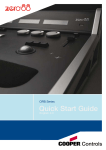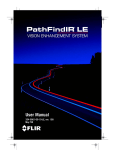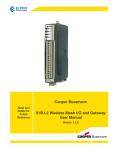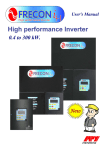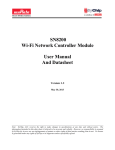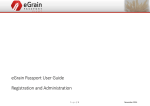Download 915U-D20-900/2400 Serial Data Radio
Transcript
915U-D20-900/2400 Serial Data Radio User Manual 900MHz and 2.4GHz Versions Models: 915U-D20-900 915U-D20-2400 ELPRO Technologies 9/12 Billabong Street, Stafford QLD, 4053 Australia. www.cooperbussmann.com/BussmannWireless Technical Support America (866) 7134409 Rest of the world +617 3352 8624 V1.1.4 Contents Chapter 1 - Safety and Precautions ...........................................................................4 Chapter 2 - Regulatory ................................................................................................4 Chapter 3 - Product Overview ....................................................................................5 3.1 Basic Features .............................................................................................................................. 5 3.1.1 Radio Description ...................................................................................................................... 5 3.1.2 Model Numbers ......................................................................................................................... 5 3.1.3 RS232 and RS485 Serial Ports ................................................................................................ 5 3.1.4 USB Port Programming Interface ............................................................................................. 5 3.2 Wireless Introduction .................................................................................................................. 6 3.2.1 Spread Spectrum....................................................................................................................... 6 3.2.2 Frequency Hopping ................................................................................................................... 6 3.3 Master/Slave Network Configuration ........................................................................................ 7 3.3.1 Master/Slave Topology ............................................................................................................. 7 3.4 Encryption and Security ............................................................................................................. 8 3.4.1 Frequency Hopping ................................................................................................................... 8 TM 3.4.2 Trusted Wireless Protocol..................................................................................................... 8 3.4.3 Network Address and Security ID............................................................................................. 8 3.4.4 Encryption .................................................................................................................................. 8 Chapter 4 - Connections and Powering Up ..............................................................9 4.1 Power Connections ..................................................................................................................... 9 4.2 USB Connections ....................................................................................................................... 10 4.3 RS232 and RS485 Connections ............................................................................................... 10 4.3.1 RS232 Connections: ............................................................................................................... 10 4.3.2 RS485 Connections: ............................................................................................................... 12 4.3.3 RF Link Contact ....................................................................................................................... 13 4.3.4 Antenna Connection ................................................................................................................ 13 4.3.5 Mounting .................................................................................................................................. 14 Chapter 5 - Module Configuration ...........................................................................15 5.1 Reference .................................................................................................................................... 15 5.1.1 Installing the Driver: ................................................................................................................. 15 5.1.2 Setting your PC to Connect to the Radio: .............................................................................. 15 5.1.3 Factory Default options ........................................................................................................... 16 5.1.4 Logging into the Radio: ........................................................................................................... 17 5.1.5 Configuration Operation .......................................................................................................... 18 5.1.6 Configuring IP Address & Subnet Mask ................................................................................. 18 5.2 Configuration .............................................................................................................................. 20 5.2.1 Home Page Information .......................................................................................................... 20 5.2.2 Radio Configuration (900 & 2400 screens) ............................................................................ 21 5.2.3 Serial Ports Configuration ....................................................................................................... 26 5.2.4 Clock/Sleep Configuration (900 & 2400 screens).................................................................. 29 5.2.5 Remote Radio Access............................................................................................................. 30 5.3 Review/Apply Changes ............................................................................................................. 31 2 5.4 Maintenance ................................................................................................................................ 32 5.4.1 Factory Defaults ....................................................................................................................... 32 5.4.2 Reset ........................................................................................................................................ 32 5.4.3 Firmware Update ..................................................................................................................... 33 5.5 Diagnostics ................................................................................................................................. 34 5.5.1 Radio Test Mode ..................................................................................................................... 34 5.5.2 Radio Channel Statistics ......................................................................................................... 35 5.5.3 Radio Statistics ........................................................................................................................ 36 5.5.4 Radio Status ............................................................................................................................ 38 Chapter 6 - Troubleshooting ....................................................................................39 6.1 Status LED Indicators................................................................................................................ 39 6.1.1 RF Link LED Function: ............................................................................................................ 39 6.1.2 Tx and Rx LED Functions (Transmit and Receive) ............................................................... 40 6.1.3 Received Signal Strength Indicator (RSSI) ............................................................................ 41 Chapter 7 - Network Planning ..................................................................................42 7.1 Selecting the Site ....................................................................................................................... 42 7.1.1 Power Source .......................................................................................................................... 42 7.1.2 Mounting Structure for the Antenna........................................................................................ 42 7.1.3 Convenient Access to the Radio for Troubleshooting ........................................................... 42 7.1.4 Temperature and Humidity Control ........................................................................................ 42 7.1.5 Radio Propagation Path .......................................................................................................... 43 7.1.6 Fade Margin ............................................................................................................................. 43 7.1.7 Antennas and Cabling ............................................................................................................. 43 7.1.8 Co-axial Cable Considerations ............................................................................................... 43 7.1.9 Antenna Selection ................................................................................................................... 44 7.1.10 Antenna Mounting Considerations..................................................................................... 44 7.2 Maintaining System Performance ........................................................................................... 45 7.2.1 Antennas and Co-axial Cable ................................................................................................. 45 7.2.2 Power Supply........................................................................................................................... 45 7.2.3 Grounding ................................................................................................................................ 45 Chapter 8 - Specifications.........................................................................................47 8.1 Environmental ............................................................................................................................ 47 8.2 900 MHz Radio Specifications: ................................................................................................ 47 8.3 2.4GHz Radio Specifications:................................................................................................... 48 Appendix A ....................................................................................................................49 3 Chapter 1 - Safety and Precautions WARNING: EXPLOSION HAZARD Do not disconnect equipment unless power has been switched off and the area is known to be non-hazardous. Chapter 2 - Regulatory This device complies with Part 15 of the FCC rules. Operation is subject to the following two conditions: (1) This device may not cause harmful interference, and (2) this device must accept any interference received, including interference that may cause undesired operation. Model - 915U-D20-900 FCC ID: IA9-OEM900MR CAN ID: 1338B-OEM900MR Model - 915U-D20-2400 FCC ID: IA9-OEM2400MR CAN ID: 1338B-OEM2400MR FIGURE 1 4 Chapter 3 - Product Overview 3.1 Basic Features 3.1.1 Radio Description The 915U-D20-900/2400 is a wireless transceiver capable of sending and receiving digital data. The electrical interface is RS232 and RS485. It features a variable overthe-air data rate from 125kbps to 500kbps for the 900MHz radios and 19.2kbps to 250kbps for the 2.4GHz radios. It utilizes the license free spread spectrum 900MHz or 2.4GHz bands. Frequency hopping technology ensures reliable operation in high interference environments. The design is intended for industrial applications – this features a wide outdoor operating temperature range, protection against common wiring errors, class 1 manufactured electronics, compatibility with common industrial protocols and housing/materials designed for harsh environments and handling. 3.1.2 Model Numbers This manual covers 2 versions of the 915U-D20-900/2400 radio system. They are as follows (XX is Country Specific): 915U-D20-900XX: 900MHz transceiver, IP20 DIN rail mount enclosure 915U-D20-2400XX : 2.4GHz transceiver, IP20 DIN rail mount enclosure 3.1.3 RS232 and RS485 Serial Ports The 915U-D20-900/2400radio system includes a RS232 and a RS485 serial port, both of which are available on a terminal block. The RS232 port provides for 5 connections; TXD (transmit data), RXD (receive data), GND (ground), and if handshaking is being used, CTS and RTS (clear-to-send and ready-to-send). The RS485 port is half duplex, providing 2 connections plus a ground on the terminal block. RS485 termination resistor is selectable via Configuration Software. Both serial ports can be used simultaneously, but are only used for transmitting and receiving user data. Configuration is done through the USB port. 3.1.4 USB Port Programming Interface There is a mini-B USB connector on the radio for configuration. It connects to a PCs USB port using a standard USB 2.0 adaptor cable (USB A Male to Mini-B Male). (Recommended cable details below) Part No. AK672M/2-2-R 3021009-06 Manufacturer Assmann WSW Components Qualtek 5 It is identical to the cable used to interface many digital cameras to PCs. This USB connection can power the radio during configuration only. It does not power the RF module for normal operation. The USB interface offers many advantages over traditional serial or Ethernet interfaces: No baud rate, parity, or other serial port parameters to match after initial setup Power connections do not need to be made for configuration USB connection provides a completely separate „Ethernet over USB‟ connection which will not interfere with existing Ethernet connections (i.e. e-mail access and Existing Network connectivity is retained while logged into the radios network). 3.2 Wireless Introduction 3.2.1 Spread Spectrum Spread Spectrum is a term used to define a wireless system that uses a wide band, but not the entire band all the time. (If it used the wide band 100% of the time, it is referred to as a wide band system). There are 3 commonly used frequencies that spread spectrum radios can use – 900MHz, 2.4GHz and 5.8GHz. They are referred to as ISM (Industrial, Scientific and Medical) bands. Radios using this band must be tested to meet regulatory authority rules (such as FCC in the USA or Industry Canada), and then can be used anywhere in that country, with no additional permits or licenses required. 3.2.2 Frequency Hopping Frequency hopping is a spread spectrum technique where a radio hops to different frequencies across the band. The hopping pattern is a pseudo random pattern programmed into both the transmitter and receiver. The 915U-D20-900/2400hopping patterns were developed to minimize the likelihood of repeating patterns of frequencies. This means that two radio networks can be using the same hopping frequencies but different hopping patterns. If they both transmit on the same frequency at the same time, the next frequency each network will hop to will be different, ensuring minimal interference between two neighboring networks. Frequency hopping is used by militaries around the world for secure and reliable communication. By changing frequencies, interference on one frequency is avoided by hopping around it. Interference must span the entire ISM band in order to effectively block this type of radio. After data is received on a frequency, it undergoes a CRC (cyclical redundancy check) to determine if any of the data encountered interference. If it does, the data is dismissed, and the radios hop to a new frequency. 6 3.3 Master/Slave Network Configuration 3.3.1 Master/Slave Topology The radios operate in a master – slave topology, with repeaters permitted. All data sent into the master serial port appears at all repeater and slave serial ports. Data sent into slave or repeater serial ports appears only at the master‟s serial port. There is no limit on the number of repeaters or their location within the network. Repeaters have dual functionality as repeater-slaves. End devices can be connected to a repeater‟s serial ports(s) and function identically as though it were a slave. FIGURE 2 Adding a repeater will cause a reduction in throughput in the network as the radios will go from a 2-hop cycle (alternating between transmit and receive) to a 4-hop cycle (master transmit, repeater transmit to slave, repeater receive from slave, repeater transmit to master). Additional repeaters will not cause any additional reduction in throughput, unless interference is present, and the radios must retry its transmissions. All communications are typically controlled by the master, since the 915U-D20900/2400is a half duplex radio. However this radio incorporates technology that allows for assured delivery to the master of messages generated by a slave or repeater. This includes compatibility with “report by exception” devices. 7 3.4 Encryption and Security 3.4.1 Frequency Hopping Frequency hopping provides the first layer of defense against unwanted intruders. By hopping to different frequencies, the radio provides a moving target to a potential jammer. It has been used by militaries around the world since its development for that purpose in WWII. A jammer must create interference across the entire ISM band before the radio can be blocked. 3.4.2 Trusted Wireless TM Protocol Cooper Wireless has developed a proprietary wireless protocol, optimized for sending industrial protocols. There are many benefits to the Trusted Wireless TM protocol: Optimized for transmitting industrial protocols Manages repeaters efficiently to maximize throughput Eliminates unnecessary overhead common in public protocols like 802.11 Specialized design eliminates bandwidth intensive features. Ability for slave radio to transmit at any time (report by exception) In addition to these features, using a proprietary protocol has the security advantage that the format of the data is not publicly known. This forms an additional wall a hacker must attempt to break through. 3.4.3 Network Address and Security ID A Network Address is used by the protocol to differentiate this radio network from other 915U-D20-900/2400radio networks in the same area. A number between 1 and 4.2 billion must be entered into each radios configuration, and must be the same on all radios within the same network. In addition a Security ID value between 0 and 65,535 must be entered and common to all radios in a network. By combining the Network Address with the Security ID, the odds are astronomically small that 2 networks would ever unintentionally communicate with each other. 3.4.4 Encryption The 915U-D20-900/2400features AES (Advanced Encryption Standard) in 3 key strengths – 128, 192 or 256 bit keys. All radios in a network must use the same encryption key. AES is secure enough to be approved for use by the US Government for encryption of TOP SECRET data. 8 Chapter 4 - Connections and Powering Up 4.1 Power Connections The power requirements are a regulated 9-30VDC source. Ensure there is sufficient current (see the Specifications section for your specific models average and peak current requirements). The average power consumption value should be used for battery sources, and the peak power consumption value for DC power supplies. FIGURE 3 The bottom Earth screw should be connected to a solid earth ground using suitable wire of sufficient gauge to divert any surge currents. It is preferred to have the power supply isolated from an earth ground. Otherwise the voltage values shown in the web pages will not be accurate. 9 4.2 USB Connections The programming interface is through the Mini-B USB port which is located just below the terminal block on 915U-D20-900/2400. The 915U-D20-900/2400 does not require external power to be programmed, as the USB port can power the device, however all RF circuitry (Radio) will be powered off. This means that remote programming is not possible unless power is supplied to the device external to the USB cable. (See section 5.2.5 for details on “Remote Radio Access”) 4.3 RS232 and RS485 Connections 4.3.1 RS232 Connections: The RS232 connections are made via the terminal block. If hardware flow control is required, 5 connections must be made, including the CTS and RTS terminals. Computers are DTE (Data Terminal Equipment) devices. Some PLCs (programmable logic controllers) are DCE devices, therefore the functions of the pins on these devices will be backwards compared to a DTE device. Refer to the tables below. Connecting to a DTE device (such as a PC) Computer TxD (RS232 pin 3) RxD (RS232 pin 2) GND (pin 5) RTS (pin 7) CTS (pin 8) Radio Terminal # 8 (RxD) 7 (TxD) 9 (Signal Common) 6 (CTS) 5 (RTS) Connecting to a DCE device (such as some PLC’s) End Device (i.e. PLC) TxD (RS232 pin 2) RxD (RS232 pin 3) GND (pin 5) RTS (pin 8) CTS (pin 7) Radio Terminal # 8 (RxD) 7 (TxD) 9 (Signal Common) 6 (CTS) 5 (RTS) 10 FIGURE 6 11 4.3.2 RS485 Connections: The 915U-D20-900/2400supports both RS232 and RS485 simultaneously. Note: Note: For better surge protection of RS485 the maximum preferred cable length for RS485 connections to the 915U-D20-900/2400 radio should not exceed 10m (33 feet). However if cable lengths beyond 10m (33 feet) are required, then a shielded twisted pair must be used, with the shield connected to an earth ground at one end only. For RS485 connections, refer to the diagram below. Terminal 1 2 3 4 5 6 7 8 9 10 11 12 Connections Power (+) Power (-) RF Link Relay A RF Link Relay B RS232 RTS (used for handshaking) RS232 CTS (used for handshaking) RS232 TxD RS232 RxD Signal Common (RS232 or RS485) RS485 A (+) RS485 B (-) Signal Common (RS232 or RS485) FIGURE 4 FIGURE 5 12 4.3.3 RF Link Contact Each radio provides a dry contact that will change state depending on the status of the radio link. The contact is rated for 0.5A at 30VDC and is Normally Open (N.O.). On slave and repeater radios, the RF Link contact will close once it establishes a link with a repeater or the master. The RF Link reflects the upstream status of the radio link (i.e. if the radio is a repeater, it will show the status of the link to the master only, not any downstream slaves). If the radio is a master, the RF Link is closed as long as power is applied. See the previous section for wiring terminations. FIGURE 6 4.3.4 Antenna Connection Power should be removed from the radio when connecting or disconnecting antennas. The antenna connector is an SMA. The recommended antennas are: 915U-D20-900 Model CFD-890EL, 900MHz, dipole antenna Model SG900EL, 900MHz, collinear omni directional antenna Model SG900-6, 900MHz , collinear omni directional antenna Model YU6-900 MHz, 6 Element directional Yagi antenna 13 915U-D20-2400 Model MD2400-EL, 2.4 GHz, 2 dBi dipole antenna Model SG2400-EL, 2.4 GHz, 5dBi collinear omni directional antenna Model Z2400-EL, 2.4 GHz, 10 dBi collinear omni directional antenna Model Y2400-18EL, 2.4 GHz, 18 Element directional Yagi antenna 4.3.5 Mounting The enclosure can be mounted in one of two methods: Flat panel or wall mounts DIN Rail Clip mounted Flat Panel Mounting Screw the enclosure to a flat surface using the 2 holes on diagonally opposite corners of the module. Be sure to use screws of suitable material for the environment, sufficient length and type to secure the device to the panel or wall. The screw holes will accommodate a 4mm (3/8”) diameter screw (a #8 screw). DIN Rail Clip Mounted DIN Rail mounting clip is fitted to the underside of the module and utilizes the slotted holes on the side of the module to hold the clip in place. To mount Clip – insert the two keyed tabs into the available slots on the back of the module (Clip can only be mounted one way). Press firmly until the Clip clicks into place. To remove Clip - Insert a flat blade screw driver into the slotted holes on each side of the module so that the screw driver is perpendicular to the slot. Press lightly to release the Clip. FIGURE 7 14 Chapter 5 - Module Configuration 5.1 Reference Connecting to the Radio for Configuration: 5.1.1 Installing the Driver: Copy the driver to a location on your hard drive (Driver file is available on the CD shipped with the product or by downloading for the following Website. http://www.cooperindustries.com/content/public/en/bussmann/wireless/products /industrial_wireless/industrial_wirelessmodemsdeviceservers.html Plug the USB cable into the radio and PC When the “New Hardware Found” Wizard pops up, follow the prompts to install the driver from the location you‟ve temporarily stored it to. 5.1.2 Setting your PC to Connect to the Radio: Select Windows “Start” button, “Run”, type “CMD” then <Enter>, which will create a new window with a “C:\>” prompt. Type “ipconfig /all” (without the quotes) and press the enter key. The following screen will result: FIGURE 8 15 Using the radios built-in DHCP server, the radio will assign an IP address to the new ELPRO 915U-D20-900/2400interface on the computer. The IP address is shown above in the line labeled DHCP Server. In the example above the IP address for the radio is 192.168.0.1. This is the factory default value. If the radio address has been changed in the module, the IP address of the radio will also change. For more details on configuration see section 5.1.6 “Configuring IP Address and Subnet Mask” The IP address of the radio needs to be entered into the address field of a browser such as Internet Explorer or Firefox. Once this connection is setup, it will provide an „Ethernet over USB „connection which is a completely separate network interface and will not interfere with any existing Ethernet connections, i.e. Email or company related Ethernet Network connections. Note: If the IP address of the radio is unknown the above procedure can also be used to show which IP Address has been configured into the modem. 5.1.3 Factory Default options The device provides two ways to revert its configuration back to factory default settings. Factory Defaults Using the Web Page Interface This method is preferred since it permits the user to see the configuration changes that will be applied before the changes are applied. See Section 5.4.1 “Factory Defaults” for details on how this can be done. Factory Defaults Using a Hardware Mechanism This method does not require the user to connect to the device using a web browser. Changes are applied to the device immediately without any confirmation from the user. Disconnect the USB cable if connected. Power off the device. Connect terminal block pin 5 to terminal block pin 6. Connect the device USB interface to a computer. Do not apply DC power to the device. The device will revert its configuration to factory defaults. The user can now connect to the device using the factory defaults settings. The IP address is 192.168.0.1. The subnet mask is 255.255.254.0. Do not forget to remove the connection from terminal block pin 5 and pin 6. 16 5.1.4 Logging into the Radio: Run a browser program such as IE5.5 or higher or Firefox 3.0 or higher and enter the IP address of your radio (do not include „www‟ or „http‟ in front, just the numbers with periods). The default IP address is 192.168.0.1. The Home Page will appear as follows: FIGURE 9 Note: The Radio Address is associated with the IP address and Subnet Mask of the module, therefore if one parameter is changed it may affect the other two parameters. See Section 5.1.6 “Configuring IP Address and Subnet Mask” for more details If the radio is not connected to a DC power supply and only powered through the USB port, “Maintenance Mode” will appear in red text. Note: When accessing configuration parameters while the radio is simultaneously passing large amounts of serial data, some parameters may appear blank on some menus. Refresh the page to reload blank parameters. 17 5.1.5 Configuration Operation Parameter changes made on any of the configuration screens are not written to the Radio until they have been reviewed and applied. 1. After making changes on any of the configuration screens. Complete the change by selecting the “Submit” button. 2. Select “Review / Apply Changes” from the top menu bar which will open the “Review and Apply Changes page. Any changes not written to the module will be highlighted in red text. If changes are not correct you will need to return to the appropriate page and resubmit. 3. Select the “Apply Changes” button to write the changes to the radio and reset the module. The module will automatically be taken to the Home screen when complete. 5.1.6 Configuring IP Address & Subnet Mask If fewer than 255 radios are needed in your network it is recommended that the Basic IP address configuration be used. This is to simplify configuration and to avoid addressing limitations with certain Windows Operating Systems (For Advanced IP Configuration see Appendix A). Basic IP Address and Subnet Mask Configuration The IP address will be based on the radio address which is set on the Radio Configuration page. 1. Navigate to Configuration > Radio Configuration > Radio Parameters. o Enter the Radio Address (1-254). o Click Submit. 2. Navigate to Configuration > Serial Ports Configuration. o Configure the Subnet Mask to be 255.255.254.0 (default).This does not need to change if radio address is less than 255. o Configure the IP Address that you wish to use. The Default IP range will be 192.168.0.X where X is the Radio Address which is configured from the radio address in step 1. E.g. If the Radio address is 15 the IP address will be 192.168.0.15. If the Radio address is 200 the IP address will be 192.168.0.200. If a different IP address is required then change it here, however keep in mind the last octet of the IP address is not editable as it is configured from the radio address. For more advanced configurations see Appendix A. o Click Submit 18 3. Navigate to Review / Apply Changes o Review, Changes will be indicated in red. o Click „Apply Changes‟ to save the new configuration or „Discard Changes‟ to abandon the configuration and revert back to what it was before. o Confirm the dialog box by clicking OK. The browser will be re-directed to the updated IP Address when the changes are complete. You can also type this IP Address into your browser‟s URL address bar. If you forget the IP address of the device, you can determine the IP address as follows: Connect the device to the PC via the USB cable. From a command prompt window, type ipconfig /all <Enter> The device‟s configuration should be listed as one of the networking connections. The device‟s IP Address is listed as a “DHCP Server” as shown in Figure 10 below. FIGURE 10 19 5.2 Configuration 5.2.1 Home Page Information The home page provides some important information about the radio: Device Serial Number – serial number printed on the outside of the enclosure Device Firmware Version – mother board firmware Radio Serial Number – serial number of the RF board Radio Firmware Version – RF board firmware version Uptime – Total time since the last reset Status – Will indicate the Internal Error status value, which can be referenced to the table below. “OK” 2 3 4 5 6 7 8 9 10 11 12 13 Status Message Table No Errors Reported The radio module failed to initialize The installed radio module was not the expected type of module The device file system failed to initialize correctly. The device‟s manufacturing database is misconfigured The device‟s user database is requires configuration The device‟s network address is zero The Device lost main power during steady state operation The device is operating in Maintenance Only mode. The device‟s USB interface is not consistent (Config Fault) The device‟s branding configuration (option) is not consistent. The device‟s USB interface is not consistent. (Build Mismatch) Radio configuration failed during initialization. In the lower left corner the model number of the radio is shown, and on the right, the address of the radio. Note that remote configuration is possible, therefore attention should be paid to ensure you are connected to the radio you intend to configure or diagnose. 20 5.2.2 Radio Configuration (900 & 2400 screens) Select Configuration > Radio Configuration >Radio Parameters: FIGURE 11 Radio Parameters - Network Settings: These parameters must be the same on all radios in the network. The Radio Settings can be set differently on each radio, and in some cases must be set differently. Network Address: Enter a random value between 1 and 4.2 billion. Zero (0) is invalid (factory default) and indicates that the radio needs configuration before deployment. The Network Address influences the hopping pattern the network will use (the order the radios will go through their assigned frequencies). If two networks are to be installed in the same area and both use the same RF band, select different Network Addresses to ensure different hopping patterns are used to minimize interference between them. Security ID: Enter a random value between 0 and 65,535 RF Band: There is one RF band for the 900MHz radios (not user adjustable), and three RF bands for the 2.4GHz radios. If you are deploying other 915U-D20900/2400radio networks in the same area, use different RF bands to minimize interference. The RF bands are interleaved between each other to spread the signal across the spectrum for interference and multi-path immunity. Repeaters in Network: If there are repeaters anywhere in the network, the Master radio must be aware of this, all Slaves will automatically adjust to the Master. The network will function on a 4 hop cycle instead of a 2 hop cycle, which will cut throughput in half. Therefore only select this if you are sure repeaters will be deployed. 21 Additional repeaters in the network will not cause any further reduction in throughput, except as each may need to do retries. Retransmit Broadcasts: This option will cause the master and any repeaters to repeat downstream broadcasted data (to slave radios), on different frequencies. The values range from 0 to 3. Multiple retransmissions greatly increases the likelihood that the data will get through, though it significantly impacts the total throughput of the system. Select this option when there is high interference present, weak radio links or a critical control system. Data Rate: This refers to the over-the-air data rate. All radios in the network must be set the same. As a rule of thumb, select the lowest data rate that will provide your network with the desired response time. Lower data rates will yield greater distances. The 125 and 250kbps data rates on the 900MHz radios use MSK modulation, whereas the 500kbps data rate uses GFSK modulation. MSK modulation has lower requirements for a signal-to-noise ratio, therefore this data rate/modulation method should be used when there is a high noise floor in the area. The 2.4GHz radios use GFSK for all over-the-air data rates due to regulatory and technical requirements. The 2.4GHz radios have over-the-air data rates of 19.2kbps, 125kbps and 250kbps. Frame Size: This determines how long the frequency hopper stays on each frequency. The longer the radio remains on each frequency, the more data it can transmit on that hop. The following are approximate frame sizes for the different models 915U-D20-2400 - latency (45 bytes per hop), balanced (100 bytes per hop) and throughput (232 bytes per hop) 915U-D20-900 - latency (110 bytes per hop), balanced (264 bytes per hop) and throughput (440 bytes per hop) Subtract 5 bytes if encryption is enabled. If you desire the shortest time to get a message to the receiving radio, the latency setting will ensure the radio alternates between transmit and receive cycles fastest. If data throughput is more important, the throughput setting will force radio to spend more time sending/receiving data than changing frequencies. 22 Radio Parameters - Radio Settings: Radio Mode: Master, slave or repeater. There can only be one master in any network, any number of repeaters, in any layout, with the remaining radios being slaves. Repeaters have dual functionality as both a repeater for more distant radios and a slave. If a remote radio will never be required to function as a repeater, do not assign it as a repeater as there will be a small throughput penalty. Radio Address: Each radio in the network must have a different Address. The full range is 1 to 65530 however if fewer than 255 Radios are required the address range will need to be between 1 & 254. See section 5.1.6 “Configuring IP Address & Subnet Mask” for more details on addressing. Write down the Radio Address on a label and fix to the radio. Retries: This is the number of times a slave or repeater will try to send data upstream (towards the master) in case of error. The master (or repeater) will acknowledge all messages. If no acknowledgement is received, the slave (or repeater) will resend the data. Weak radio links and high interference environments may require a higher setting. Roaming: A related parameter is Alternate Master. If roaming is enabled, a slave or repeater will lock to the first master or repeater it finds. If that radio becomes unavailable, it will roam to another radio. If roaming is disabled, you must enter the Radio Address of the master you wish this radio to link with under Alternate Master. Tx Power (Transmit Power): This adjusts the amount of RF power the radio sends out. It is generally recommended to use the minimum RF power necessary to maintain a 15dB fade margin, to accommodate other RF systems in the area. Link Timeout (tenths of seconds): This is the time the radio will wait after receiving the last successful packet from the master (or repeater) before its RF Link relay drops out, and the radio roams or looks for an alternate master. Radio Parameters - Alternate Master Address Settings: Alternate Masters Address (1, 2, and 3): Applicable to slave and repeater radios and only when roaming is set to No. This option determines which master (or repeater) a repeater/slave radio will try to link to. Setting Roaming to Yes, in some topologies, could allow a slave to link to a master even though the link quality is poor. To prevent this, disable Roaming and enter the Radio Address of the repeater you wish the radio to link to. There is no priority sequence if multiple masters are enabled. A slave will link to the first master/repeater it finds, regardless of link quality. 23 Radio Encryption AES Encryption is supported, with 3 possible levels. The encryption key must be the same on all radios within a network. To access wireless encryption, select Configuration > Radio Configuration > Radio Encryption. FIGURE 12 To enable encryption, select the key size and enter a key. Only hexadecimal characters may be used (0-9 and a-f or A-F). As an alternate, you may have the program randomly generate a key. Write this key down and store it in a safe location. You will need this information if you add additional radios to the network at a later date. Select “Submit” and “Apply Settings”. 24 Frequency Avoidance (915U-D20-2400 Only) Frequency Avoidance enables the radio to avoid certain frequencies used by other systems. The 2.4GHz radios can avoid up to 2 WLAN channels as well as certain frequency blocks. The 2.4GHz radios require 27 frequencies in order to operate and abide by local regulatory authority rules. The configuration menu will display an error message if you have avoided too many frequencies. To enable Frequency Avoidance, select Configuration > Radio Configuration > Frequency Avoidance. FIGURE 13 Enter the WLAN channels to avoid and/or frequency ranges. Select “Submit”, then “Apply Settings” on the Review” screen. Note: Care should be taken when configuring Frequency Avoidance parameters to ensure all communicating devices match one another. Non matching parameters can result in partial communications, i.e. modules appear to be linked, but you will not be able to transmit any serial data. 25 5.2.3 Serial Ports Configuration The RS232 and/or RS485 serial ports must be configured to match the settings on the device they will be connected to. This menu also allows configuration of the USB port/programming interface. The following settings must be the same on the radio and the end device in order for them to communicate: Baud rate Data bits Parity Stop bits Flow control To configure the serial and USB ports, select > Configuration > Serial Ports > Configuration. FIGURE 14 Baud Rate: This is the speed that data will flow through the port. The settings of 31.25k, 45.45k and 93.75k are for the Profibus protocol. Data Bits: This determines how many bits will make up a frame of data. The majority of protocols use 8 bits. Parity: This is a method for detecting errors in a transmission. Possible selections are even or odd or none. Most equipment uses no parity. 26 Stop Bits: This determines how many bits mark the end of a frame of data. The most common setting is 1. Flow Control: The radio supports hardware flow control (CTS and RTS), which uses pins 7 and 8 on the RS232 connector (applicable to RS232 only). Hardware flow control works by regulating the data flowing into and out of the transmitting radio. By doing so, it will prevent data flowing into the radio faster that it can be transmitted out over-the-air, preventing lost data. It should be enabled in circumstances where the messages sent into the radio are larger than the radio‟s buffer of 4K bytes, and particularly when the serial port speed is faster than the radios over-the-air speed. Note that the radio over-the-air speed is divided between transmit and receive, and can be slowed by radio settings such as Retransmit Broadcasts and Repeaters in Network as well as any outside radio interference in the area. Connection Mode: This refers to whether the receiving radio buffers a message until the entire message has been received, and then sends it out its serial port in a continuous fashion, or whether it sends the message out in small portions as it arrives. Options below: Packet - To buffer a message for Modbus, Profibus or similar packet mode protocols Streaming - For protocols that use a symbol to determine the end of a message. Serial Channel Protocol: If using one of three protocols (Modbus RTU, Profibus, DF1), the master radio will determine which slave radio is connected to each Modbus/Profibus/DF1 slave device during the first successful round of polling. It builds up a Routing Table matching the slave Radio Address to the Modbus/Profibus/DF1 address. In subsequent polling, the master radio will request an acknowledgement from the matched slave radio that the message was received. If it does not receive the acknowledgement, the master will retry sending the message until the acknowledgement is received. The number of retries the master will do before giving up is specified under Retries in the Radio Parameters menu. To enable this feature, select the protocol your network is using. This feature has no effect on slave radios, as normal messages from slave to master are acknowledged regardless of protocol. Routing Table Timeout: (in seconds) Related to Serial Channel Protocol, if that feature is enabled, a value needs to be entered in Routing Table Timeout. This is the time the master and repeater radios will retain the routing table in their internal memory. After this time expires, a new routing table will be created. This is necessary as some radio paths may become unavailable due to power loss, equipment damage, etc. A recommended default value is 20 minutes (1200 seconds). A value of 0 can be set to prevent the routing table from being cleared. Serial Channel Mapping: Data that goes into the serial port of one radio can be sent to either serial port of another radio, and vice versa. This is done by mapping each serial port to a channel. There are 2 independent serial channels. A serial port that is 27 not mapped to a channel will be inactive. To have data sent to the RS232 ports of all radios, ensure they are all mapped to the same channel. Simultaneously, independent data (even different protocols), could be passed among the RS485 ports by using the second channel. Data can be passed between the RS232 and RS485 ports of the same radio by mapping both serial ports to the same channel. (In this application, care must be taken to ensure that both serial ports don‟t attempt to transmit data at the same time). End Point Termination: Enabling this will insert a 120 ohm termination resistor to prevent the reflection of signals. Enable this if this radio will be at the end of a RS485 loop, particularly if there are long cable runs involved. USB Port Configuration: These settings affect how access via the USB port is configured. IP Address: This is the address you will need to type into the Address Bar of your web browser each time you wish to access the radio. See Section 5.1.6 “Configuring IP Address & Subnet Mask” for details on how this is changed Subnet Mask: The mask used to determine which bits are read. The last byte is typically 0 (zero). See Section 5.1.6 “Configuring IP Address & Subnet Mask” for details on how this is changed Device Name: This is text stored in the internal memory of the radio, cosmetically used for identifying individual radios within a network. Common names would be the location where the radio is to be mounted. 28 5.2.4 Clock/Sleep Configuration (900 & 2400 screens) Note – Sleep Configuration is only available on 2.4GHz radios. These settings allow you to set the radio into sleep mode to reduce power consumption for solar or battery power sources. Sleep mode power consumption will be approximately 22% of the normal current draw. To enable Sleep Mode, select Configuration > Clock/Sleep Configuration. FIGURE 15 FIGURE 16 Enter the time and date, or have it set to your PC‟s time and date by selecting “Set value to PC Time”. Double check the time your PC is set to, as well, ensure it is set to the correct time zone. Note that daylight savings time is not accounted for. Click your mouse in the “Enable Sleep Mode” box. The “Wake Up Time” refers to the time the on/off cycle starts, and is reset every 24 hours. Enter an On Time as well as an Off Time. The sum total of the on duration and the off duration will determine the radio cycle time. For example, if the on duration is 10 minutes and the off duration is 50 minutes, the total cycle time will be 60 minutes. If the cycle time is not an even multiple of 24 hours, the cycle will be forced to restart with the on duration every 24 hours at the Wake Up time. Be sure to allow sufficient time for other equipment to boot up/warm up, readings to stabilize and data to be received and sent back to the master station. A common method of operating the sleep timer is to have the radio wake-up as often as necessary. The master device polls continuously, 24 hours a day, and gracefully accepts communication errors when the slave radio is sleeping. 29 5.2.5 Remote Radio Access Remote access to any radio is supported from any other radio if they have a solid RF link. All functions possible when directly connected to a radio can be accessed remotely. This includes any configuration change and firmware upgrades. To access a remote radio, connect to the USB port on your local radio and open the Remote Radio Connect‟ screen (below). Next, enter the IP address of the remote radio. You will then be directed to the remote radios home page. Be aware that if there is serial data traffic being sent simultaneously, it will take priority. It is possible that some parameters may appear blank because of a high volume of serial data traffic. Caution: If network setting changes are made to a remote radio, it will lose link to the master until the master‟s network settings are adjusted to match it. Careful planning is required to ensure that network upgrades can be done without a lot of disruption. FIGURE 17 30 5.3 Review/Apply Changes This menu allows you to review any changes made to the configuration before they are sent to the radio. Changes that are not yet implemented will appear in red. Review all changes carefully before selecting the “Apply Changes” button, which will save all settings to the radio. Refresh the page after implementing. Note: 915U-D20-900 & 915U-D20-2400 Review and Apply screens are marginally dissimilar due to differences in configuration parameters. FIGURE 18 31 5.4 Maintenance 5.4.1 Factory Defaults FIGURE 19 This feature allows the user to restore the modules to its Factory Default values. The user must be able to connect to the device using the web interface. Connect to the device using a web browser. Navigate to Maintenance > Reset Click “Reset to Factory Defaults” Click “OK” to the confirmation dialog box. The device has accepted the request, but has not yet saved the factory defaults settings. Manually navigate to Review / Apply Changes to complete the operation. Click Apply Changes to complete the operation. This saves the factory default settings and resets the device so the new settings take effect. Or click Discard Changes to abandon the operation. 5.4.2 Reset This feature allows the radio to be reset to or re-booted. The reboot feature re-starts the radio, which is the equivalent of cycling power. It is useful when remotely accessing radios via the over-the-air link. The web page needs to be refreshed after this function 32 5.4.3 Firmware Update Periodically, new versions of firmware will be made available which will enhance performance and/or add new features. If problematic operation is encountered, after basic troubleshooting, the firmware version should be reviewed to ensure it is the most recent. The following link provides a location were firmware updates will be available. Be sure to download the version applicable to your model: http://www.cooperindustries.com/content/public/en/bussmann/wireless/products/industr ial_wireless/industrial_wirelessmodemsdeviceservers.html There is firmware for the RF board and firmware for the device. The radio will automatically determine which firmware has been downloaded and install it to the RF board, device or both. To upgrade the firmware, select Maintenance > Firmware Update. FIGURE 20 Click “Browse” to locate the file, and click “Update Firmware”. Note: If power fails, the USB connector unplugged or other failure occurs during an update, it may not have completed the update and you will have to repeat the process. Power must be cycled if the firmware update process is interrupted. It is generally recommended that all radios in a network have their firmware upgraded rather than selectively upgrading some radios. Configuration settings are retained after a firmware update. 33 5.5 Diagnostics 5.5.1 Radio Test Mode By selecting one of the two options, the RF power output and Voltage Stand Wave Ratio (VSWR) can be measured, or, the Background Noise level can be measured. FIGURE 21 RF power output and VSWR: Select the “Fixed Frequency” mode and click “Submit”. For 30 seconds the radio will not hop, but instead transmit continuously at 2.4015GHz or 902.15MHz depending on the model. After the 30 second timeout the radio will stop transmitting. To have the radio transmit at a fixed frequency for another 30 seconds, select “Submit”. Power must be cycled to resume normal frequency hopping operation. See Section 0 “ Antenna Selection” for more information on power and VSWR measurements. Note that power to the radio should be removed when connecting and disconnecting antenna cables. Background Noise Measurement: This feature is useful to determine the noise floor in each radio‟s location. The received signal strength needs to be a minimum of 10dB greater than the noise floor for successful reception. The peak noise is an indication of the maximum noise received by the radio system. If the peak noise is high but the average noise low, interference is only occurring on a few channels, and successful operation can be planned for. To measure the background noise, ensure the antenna is connected and aimed towards the opposite radio, select “Background Noise Measurement” and click “Submit”. After 30 seconds the radio will complete the measurement and display the results in dBm on the web page. To repeat the test, select “Submit”. Power will need to be cycled to return to module to its normal operation. 34 All other radios in the network should be powered off such that they do not contribute to the noise floor measurement. 5.5.2 Radio Channel Statistics This feature allows you to see how well the radio is communicating on each of the frequencies in use. If you see that some frequencies have very low success rates, you may be able to avoid those frequencies (depending on the model) to improve the radios performance. To use this feature, power up the radios and pass serial data back and forth for some period of time, the longer the time period, the greater the accuracy of the statistical data. Since master radios always transmit in order to maintain network synchronization, it is not necessary to pass serial data if checking statistics on slave radios. Log into the radio, and select Diagnostics > Radio Channel Statistics. FIGURE 22 Note – 50 channels will be shown for 900MHz, and 27 channels for the 2.4GHz radios. Received: This is the number of packets (1 per frequency hop) received by the radio that passed the CRC16 error check and were therefore valid. Lost: This is the number of packets that failed the CRC16 error check, and were discarded. RSSI (Received Signal Strength Indication): This is a measure of how strong the RF signal was on that particular frequency (expressed in dBm). It is normal to see some 35 variation among frequencies due to multi-path effects. RSSI measurement does not apply on the Master radio. 5.5.3 Radio Statistics This menu provides critical data for determining how well a radio is performing within a network. It should always be consulted when troubleshooting. To access this menu, select Diagnostics > Radio Statistics. FIGURE 23 Note: The numbers presented are all relative. If the maximum count on one parameter is reached, all counts are divided by 2. There are some exceptions on parameters that are not comparable to other parameters, such as Lost Link Count, Device Hard Resets and Buffer Overrun Errors. Rx Frames Received: The number of valid frames received by the radio. One frame is transmitted on each frequency hop. Slave radios do not transmit anything unless data is sent into its serial port. Rx Errors: The number of frames that failed the CRC16 error check. This value will always be correct relative to the Rx Frames Received count. RX Dropped Frames: The number of frames that were dropped due to the buffer on the receiving radio being full – received over the RF link. This value will always be correct relative to the Rx Frames Received count. RF Link Lost Count: The number of times the radio has lost RF Link since the last power cycle. Rx Success Percent: The ratio of valid frames to the total number of frames received. 36 Tx Assured Frames: The number of frames transmitted via the RF Link that required an acknowledgement. Assured Frames are those that get sent to a specific radio address. This applies to all web traffic. Serial data sent from the master is broadcast to all slaves (unless auto-routing is turned on), and so the data will be sent via an unassured connection. Auto-routed data goes to a single address and is sent Assured. All data sent from a slave to the master is always going to a single radio (the master) and is therefore sent assured. Tx Retries: The number of frames re-transmitted due to RF errors. Tx Dropped Frames: The number of frames discarded after retries exhausted. The following 3 parameters apply only to the Repeaters transmitting to Slaves: Repeated Tx Assured Frames: The number of frames transmitted via the RF Link that required an acknowledgement. Repeated Tx Retries: The number of frames re-transmitted due to RF errors Repeated Tx Dropped Frames: The number of frames discarded after retries exhausted Power Cycles: The number of „Hard Resets‟ of the Microprocessor due to loss of power or improbable hardware failure. RS232 Rx Errors: Shows the number of RS232 receive bytes that have been lost while sending to the radio from an RS232 device. RS232 Tx Errors: Shows the number of RS232 transmit bytes that have been lost while sending from the radio to an RS232 device. RS485 Rx Errors: Shows the number of RS485 receive bytes that have been lost while sending to the radio from an RS485 device. RS485 Tx Errors: Shows the number of RS485 transmit bytes that have been lost while sending from the radio to an RS485 device. Channel 1 Buffer Overrun Errors: The number of bytes lost due to Packet Mode buffers overflow on Channel 1. Channel 2 Buffer Overrun Errors: The number of bytes lost due to Packet Mode buffers overflow on Channel 2. 37 5.5.4 Radio Status The Radio Status menu provides basic information on the radio system. To access this menu, select Diagnostics > Radio Status. The page will look slightly different on master vs. slave radios. The screen capture below is from a slave. FIGURE 24 RSSI (Received Signal Strength Indicator): This is a measure of how strong the RF signal is, in dBm. The RSSI should be 15dB above the threshold of reception for reliable communications. On repeater radios this measures the link between the repeater and master. It is not functional on master radios. Link Status: This tells you if the radio has established an RF Link. This is not functional on master radios. On repeater radios it refers to its link with the master. Master Address: This is the Address of the master or repeater radio this device is linked to. It is not shown on master radios. Power Supply Voltage: Voltage at the input terminals Temperature: Temperature in degrees C inside the module 38 Chapter 6 - Troubleshooting 6.1 Status LED Indicators The radio has the following LED‟s: RF Link: Provides status of the RF Link and link quality RF Receive: RF data being received via the radio and directed to its serial port * RF Transmit: RF data being broadcast over the radio from the serial interface * RS232 Rx: Status of RS232 data being received into the radio‟s serial port RS232 Tx: Status of RS232 data being sent out the radio‟s serial port RS485 Rx: Status of RS485 data being received into the radio‟s serial port RS485 Tx: Status of RS485 data being sent out the radio‟s serial port * These LEDs will not flash if the radio is a repeater and is simply forwarding data to another radio rather than processing the data locally. A repeater receiving broadcast data from a master flashes the RF Receive LED, but not the RF Transmit LED. 6.1.1 RF Link LED Function: Description Master Radio powered on (may or may not be linked) Slave or Repeater Radio linked with 15dB fade margin Slave or Repeater Radio linked with less than 15dB fade margin Slave or Repeater Radio not linked Radio needs configuration Radio in configuration mode only (RF activity off) Sleep mode Internal Error Red Green On Solid On Solid Medium flashing (on for 0.25 sec, off for 0.25 sec) Fast flashing (on for 0.5 sec, off for 1.5 sec) Fast flashing (on for 0.25 sec, off for 1.75 sec) Medium flashing (on for 0.5 sec, off for 0.5 sec) Off for 59.5 sec, on for 0.5 sec On for 0.25 sec, off for 0.25 sec 39 6.1.2 Tx and Rx LED Functions (Transmit and Receive) Label Solid Green RF Rx No data passing RF Tx No data passing RS232 Rx RS232 Tx RS485 Rx RS485 Tx Serial channel assigned, physical connection detected Serial channel assigned, physical connection detected Serial channel assigned, no data flow Serial channel assigned, no data flow Flashing Green Radio receiving data Radio transmitting data Solid Red RF circuitry not powered on RF circuitry not powered on Serial channel assigned, no physical connection detected Serial channel assigned, no physical connection detected Data lost due to buffer overflow Data flowing normally X Data lost due to buffer overflow Data flowing normally X Data lost due to buffer overflow Data flowing normally Data flowing normally Flashing Red X X Data lost due to buffer overflow The layout of the LED‟s is as follows: FIGURE 25 40 6.1.3 Received Signal Strength Indicator (RSSI) The radio provides 2 methods of determining the RSSI. The Configuration program as described in section 5.5.4 "Radio Status”. Two voltage test points in line with the indicator LED‟s on the front panel provide a 0-3.3VDC output representing the RSSI. The voltage output provides a quick method of determining the signal strength which will aid in aiming antennas. Place the positive lead of your voltmeter on the test point labeled „RSSI‟ and the negative lead on the test point labeled „GND‟. At 2.0V there will be a 15dB fade margin, at 2.5V there will be a 25dB fade margin, and the threshold of reception will be at 1.25VDC. Scaling of the voltage output is 10dB per 0.5VDC. The voltage output will vary due to multi-pathing. A 2.0VDC signal minimum is recommended to allow for degradation of the RF link over time. FIGURE 26 -45 500kbps -55 250kbps dBm -65 125kbps -75 -85 -95 -105 1.25 1.75 2.25 2.75 3.25 3.75 Volts FIGURE 27 41 Chapter 7 - Network Planning 7.1 Selecting the Site Each location for master, slave or repeaters requires the following: 7.1.1 Power Source Power source can be provided by a 120/240VAC step-down transformer with further rectification to reduce the voltage down to 9-30VDC. Or an external solar power source with battery. It is recommended to have the power supply isolated from ground for more effective input protection. 7.1.2 Mounting Structure for the Antenna Depending on the range, there must be some accommodation for mounting the antenna at a suitable height to overcome obstructions and provide Fresnel Zone clearance. This could be a pole embedded in a concrete base or a building with access to the roof. For long range installations this may require the construction of a tower complete with guide wires for support. The antenna mounting structure must be strong and rigid enough to minimize sway in the highest wind speed the area is likely to encounter. The mounting structure can be either wood or metal, it is recommended that this structure be grounded. Grounding requirements are discussed later in this section. 7.1.3 Convenient Access to the Radio for Troubleshooting Ideally the equipment should be mounted at ground level or a location that has convenient access as a laptop PC must be used to make periodic configuration changes and troubleshooting diagnostics. 7.1.4 Temperature and Humidity Control If ambient temperatures are expected to drop below -40C/F, a heat source must be placed inside the enclosure or some accommodation made to ensure this temperature limit is not exceeded. Similarly, if ambient temperatures inside the enclosure are predicted to exceed 149F/65C a sun shade, fan or air conditioning system should be utilized. Humidity must not exceed 90% and never condense on the internal electronics. 42 7.1.5 Radio Propagation Path The radio link should be evaluated to ensure there is at least a 15dB fade margin. This will allow for degradation of equipment and foliage growth, while still ensuring reliable communications for years. The radio link can be evaluated by testing the link with the same model of radio, antenna and co-axial cable you plan on installing. A field test is always the most accurate. If the antennas must be elevated higher than is practical during a field test, a software path loss study can be performed to estimate the signal strength. The GPS coordinates of each location are entered into a software program that has the topographical data for the area. It will calculate the antenna height required for reception. Note that software studies do not normally take into account obstructions such as trees and buildings. Therefore a site visit is mandatory. If the antenna height estimated by path loss software is excessive, and no nearby mounting structures available, consider using a repeater at a mid point. Even with solar power, these can often be less expensive than erecting a very tall tower. 7.1.6 Fade Margin A 15dB fade margin is recommended to allow for degradation of equipment and increased obstructions in the path. A lower fade margin can be tolerated in less critical applications and where no foliage growth could obstruct the signal. The fade margin can be adjusted by changing the transmit power of the radios, using higher quality/lower loss co-axial cable and/or higher gain antennas. Never operate a radio at the threshold of reception as communications will be intermittent. 2.4GHz radios in outdoor paths should allow for rain fade. Depending on the severity of precipitation in the area and the distance, an additional 10dB fade margin should be considered. 7.1.7 Antennas and Cabling Quality cables and antennas must be used to ensure performance of the radio. Using low grade components will create problems in the future. 7.1.8 Co-axial Cable Considerations The co-axial cable used should be suitable for the environment, specifically, rated for the temperature and designed to prevent moisture penetration. Minimize the number of connectors used, as each one will cause a slight loss of signal and presents a point of failure. Connections should be suitably weather proofed by wrapping them in 3M weather proof tape. When installing the radios in a NEMA 4X weather tight electrical box, the penetration for the co-axial cable should be made on the bottom of the box and a drip loop created. Quality co-axial cable should be used such that signal loss is minimized. The following table shows the signal loss that occurs with common types of cable: 43 Cable Type RG58 RG213 LMR400 Heliax LDF6-50A Loss at 900MHz 16dB/100 feet 7.7dB/100 feet 3.9dB/100 feet 0.8dB/100 feet Loss at 2.4GHz 30dB/100 feet 14.5dB/100 feet 6.6dB/100 feet 1.4dB/100 feet 7.1.9 Antenna Selection Without a high quality antenna, system performance cannot be realized. The antenna must be able to resist corrosion, strong enough to withstand the maximum wind the area is likely to experience and have suitable gain for the distance/obstructions. The VSWR of the antenna is critical to ensuring RF energy is propagated into the environment rather than reflected back into the radio. A VSWR of less than 2:1 must be accomplished. Proper impedance matching (50 ohm) will ensure maximum power transfer. An antenna that has the narrowest operating frequency will have better performance than one with a wider operating frequency. Repeater sites must ensure that both the slave and master are within the beam width of the antenna. This usually means an omni antenna must be used. 7.1.10 Antenna Mounting Considerations Antennas should be mounted away from other sources of interference. For 900 MHz radios with up to 5W of transmit power, 10 feet of vertical separation is recommended. For 2.4GHz 5 feet of vertical separation is recommended. These distances provide a very general rule of thumb and are influenced by the following factors: Interferers frequency Distance between transmitter and receiver Transmit power of the interferer Alignment of the interferer‟s antenna If a source of interference is very close to your operating frequency, the filters will be less effective in blocking this interference, and more antenna separation should be used. If you are transmitting across a very long distance, then the received signal will be closer to the threshold of reception, and as such, will require a lower noise floor. To get the noise floor lower, increase the distance between the antenna and the interference source. In the event the transmit power of the source of interference is high, then naturally it will require greater separation than a lower powered source of interference. Lastly, alignment of antennas is important. Avoid placing your antenna directly in front of a yagi antenna. Careful planning when designing the system entails some research into what other antennas and radio systems are mounted on the tower or building. 44 7.2 Maintaining System Performance 7.2.1 Antennas and Co-axial Cable Antennas should be checked periodically for corrosion and to ensure the mounting bolts are tight. Co-axial cable should be checked for signs of wear and to ensure the connectors are tight and moisture and corrosion free. A VSWR (voltage standing wave ratio) measurement should be made periodically to ensure that the antenna and coaxial cabling system is functioning as originally installed. Cable Connections One of the more common problems with radio systems is the connectors. They should be tight, free of corrosion, and weatherproof. If crimping or soldering your own connectors onto a length of co-axial cable, test the new cable/connector configuration at the frequency of your radio. A simple conductivity test using at Ohmmeter is not sufficient. 7.2.2 Power Supply The power source should be checked to ensure sufficient current and voltage is supplied to the radio. A common problem is additional equipment added to a control cabinet without regard for the increased load on the power supply. A frequency hopping radio consumes large amounts of power during transmit cycles but little on receive. If sufficient current is not available when the radio goes into transmit mode, in mild cases the range of the radio will be reduced, in more severe cases the radio may stop operating. An oscilloscope should be used to evaluate the voltage if it is suspected it may drop below the radios specified input. Though the radio can tolerate a wide range of power supply input voltages, a regulated supply, that varies by no more than +/-10% of the rated voltage, should still be used. 7.2.3 Grounding The radio system should be grounded for protection against lightning strikes. Grounding requirements are beyond the scope of this manual. This section provides very general recommendations. Grounding does not affect propagation or the antenna system, except with regards to lightning strikes. If the antenna is installed indoors, grounding is not required in most cases. A single point ground should be used by all equipment that is electrically connected. The use of surge protection equipment to divert voltage surges to earth ground via ground straps or wires must be used to prevent damaging surges through the electronic equipment. If there is more than one ground point, damage can occur as current travels from one ground to another (through electronic equipment), such as during a nearby lightning strike; the closer earth ground will have a higher potential, creating a damaging ground loop. A lightning strike can cause damage by striking the antenna and travelling down the co-axial cable to the radio. Electricity will travel at different speeds down the center 45 conductor as it would down the shield, resulting in a potential voltage at the radio, causing damage. When that electricity encounters a properly grounded lightning arrestor, it will shunt the current to an earth ground, preventing radio damage. The earth ground must represent the lowest impedance path to ground. All possible sources of voltage surges should be addressed. These will include the power supply, RS232 and RS485 interfaces and the antenna. 46 Chapter 8 - Specifications 8.1 Environmental Specification Temperature Humidity Protection Wiring Terminations Wire Pass Through Mounting Antenna Connector Electrical Interface Enclosure Material RF Link Contact Approvals Description -40 to 65C (-40 to 149F) 10% - 90%, non-condensing IP20 16 – 22 AWG (power connections should be 16 – 20 AWG) N/A DIN rail or flat panel SMA (F) RS232 and RS485 via terminal block Plastic 0.5A @ 30VDC/AC UL, ATEX 8.2 900 MHz Radio Specifications: Specification Frequency Spreading Method: Modulation: OTA Data Rate: Sensitivity: Error Detection: Transmit Power: Input Voltage: Power Consumption Operating Modes: Diagnostics: Antenna: Approvals: Description 902.1 – 927.7MHz FHSS GFSK & MSK 500Kbps & 250Kbps & 125Kbps -92dBm, -98dBm & -102dBm @ PER 5% CCITT-CRC16 (ARQ IRIS Stack) 10mW – 1W (10-30dBm), user configurable 9-30VDC 150mA @ 24VDC Average, 200mA @ 24VDC Peak Point-to-Point, Point-to-Multipoint, Multipoint-to-point, Supply Voltage, Temperature, RSSI, remote diagnostics SMA FCC Part 15, Section 247; IC; RoHS; EN 61000-4-3 47 8.3 2.4GHz Radio Specifications: Specification Frequency: Spreading Method: FHSS Modulation: OTA Data Rate: Error Detection: Sensitivity: Transmit Power: Operating Modes: Diagnostics: Input Voltage: Power Consumption: Approvals: Description 2.401 – 2.4835GHz FHSS GFSK 19.2Kbps, 125Kbps & 250Kbps CCITT-CRC16 (ARQ CIRIS Stack) -96dBm, -100dBm & -105dBm @ PER 5% 1mW – 100mW (1-20dBm), user configurable Point-to-Point, Point-to-Multipoint, Multipoint-to-Point Supply Voltage, Temperature, RSSI, Remote Diagnostics 9 - 30VDC 100mA @ 24VDC Average, 125mA @ 24VDC Peak FCC Part 15, section 247; IC; ETSI EN 300-328; RoHS; EN 61000-4-3 48 Appendix A Advanced IP Address configuration The IP Address is partially configured by the device‟s Radio Address and Subnet Mask, and partially configured by the user. Consult with your IT department when choosing the IP addresses that can be used for your radio network. The table below shows the recommended private IP address ranges that can be used. Starting IP Address 192.168.0.1 172.16.0.1 10.0.0.1 Ending IP Address 192.168.255.254 172.31.255.254 10.255.255.254 Configuration Procedure 1. Identify the maximum number of Radio Addresses that you intend to use on the network from the table below. All devices on the network must use the same subnet mask. Maximum Radio Address 30 62 126 254 510 1022 2046 4094 8190 16382 32766 65530 Recommended Subnet Mask 255.255.255.192 255.255.255.128 255.255.255.0 255.255.254.0 255.255.252.0 255.255.248.0 255.255.240.0 255.255.224.0 255.255.192.0 255.255.128.0 255.255.0.0 255.254.0.0 o Record the required Subnet Mask associated with this maximum o Navigate to Configuration > Radio Configuration > Radio Parameters. o Enter the desired Radio Address. o Click Submit. 49 2. Navigate to Configuration > Serial Ports Configuration. o Configure the Subnet Mask as per recorded value from step 1 above. o Click Submit. o If the required IP Address range is different to the default 192.168.X.X, enter it here however keep in mind the Host ID portion of the IP address is not editable as they are configured from the radio address setup in step 1. E.g. If the Radio address is 2000, configure the Subnet mask to 255.255.240.0 and after clicking the submit button the IP address will be 192.168.7.208. If the Radio address is 65500, configure the Subnet mask to 255.255.0.0 and after clicking the submit button the IP address will be 192.168.127.220. If the Radio address is 5000, configure the Subnet mask to 255.255.192.0 and after clicking the submit button the IP address will be 192.168.19.136 or if using a private IP range the IP address could be 10.0.19.136 or 172.16.19.136, etc o When Complete Click Submit 3. Navigate to Review / Apply Changes o Review, Changes will be indicated in red. o Click the „Apply Changes‟ button to save the new configuration or click the „Discard Changes‟ button to abandon the configuration and revert back to what it was before. o Confirm the dialog box by clicking OK. Things to be aware of Care must be taken when configuring the Subnet Mask as entering an incorrect subnet will change the IP address to something different than expected. E.g. If the Radio Address is 1000 and a subnet mask of 255.255.252.0 is configured instead of the correct 255.255.248.0 then the IP address will be changed to 192.168.1.232 instead of 192.168.3.232. Note: Due to limitations in certain versions of Windows Operating Systems, certain IP addresses (ending with a 0 or 255) are not usable. For additional information, please refer to Microsoft Article ID: 281579 at http://support.microsoft.com/kb/281579. 50




















































